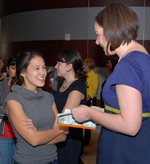|
by Cindy Abole
Public Relations
It’s no secret that many first-year medical students’ approach to
medical human dissection and gross anatomy class is likely met with
mixed feelings of excitement, trepidation or anxiety. So when the
College of Medicine (COM) introduced its new integrated curriculum
design this fall to incoming medical students, the new anatomy
component was extended as part of four longitudinal themes. Gross
anatomy is under the new structure and function theme and extends
throughout the first year.
 Psychiatrist
and author Dr. Christine Montross, right, meets first-year medical
gross anatomy student Bonnie Brooks at an Oct. 2 reception. Psychiatrist
and author Dr. Christine Montross, right, meets first-year medical
gross anatomy student Bonnie Brooks at an Oct. 2 reception.
To
prepare students for the experience and bridge their transition as
medical professionals, course directors assigned all first-year
students to read and later discuss the poignant memoir, “Body of Work:
Meditations on Mortality From the Human Anatomy Lab,” written by
Christine Montross, M.D., a writer and educator who is a 2006 graduate
of Brown Alpert Medical School (Brown University) who is now completing
her final year as a psychiatric resident.
During her first year of medical school, Montross began writing a
journal to reflect her medical school activities and experiences,
especially those connected with taking the mandatory gross anatomy
course. Montross’ efforts led her to earning a master’s degree in
ecology and evolutionary biology while attending medical school. Her
intent was to write an article for publication about these experiences
which became the award-winning book.
To emphasize the college’s new integrated anatomy component for
studying the body, Debra Hazen-Martin, Ph.D., associate dean of
curriculum integration and implementation, invited Montross to
Charleston to speak to students on the first day they entered the gross
anatomy lab and were introduced to their teaching cadaver on Oct. 2.
Prior to Montross’ arrival, students participated in a facilitated book
discussion with Hazen-Martin and David H. Bernanke, Ph.D., professor of
medicine, Department of Cell Biology and Anatomy, who serves as the
Structure and Function theme director in the integrated curriculum.
For years, medical learning through the dissection of a human cadaver
was a rite of passage for physicians in training and considered much in
the same way as how other symbols in the medical profession are
regarded, including the white coat and stethoscope, according to
Montross. All are elements of the medical school experience that
contribute greatly to the beginning journey of the doctoring profession.
“Dr. Montross’ writings focus on how anatomical dissection affects
individuals, especially those who are more sensitive to the experience
and how medical educators might underestimate the impact of human
dissection on doctors in training,” said Hazen-Martin, who was charged
to oversee the implementation of the school’s new integrated
curriculum.
In her midday address to students, Montross discussed concerns using
traditional cadaveric dissection methods in the anatomy lab versus the
use of technology’s newest advances in medical education. She reminded
the audience how medical students, physicians and other health
professionals readily use technology from communicating, analyzing lab
results to reviewing MRI images and scans of patients.
Montross feels that the loss of human dissection in medical education
would affect any type of human connection associated with the senses
including response, which includes a physician’s ability to maintain
his/her composure especially during stressful situations. She believes
that although learning about human anatomy may be better achieved
through detailed images and high-tech tools, she reminds students that
the art of caring for sick people is very real and often messy,
smelly and emotionally and physically difficult.
“Dissection gives us a glimpse of wonder into that, which the human
body affords in a way you cannot find on a screen image. It’s far
easier to appreciate the fragility, intricacy and strength of the human
heart when you’re holding it carefully in your hands. It give us awe
that we can carry to the bedsides of every patient we see and treat,”
Montross said.
As a follow up to her talk, Montross met with faculty and students at a
reception to talk more about their anatomy lab experiences and sign
copies of her book.
Friday, Oct. 23, 2009
|



